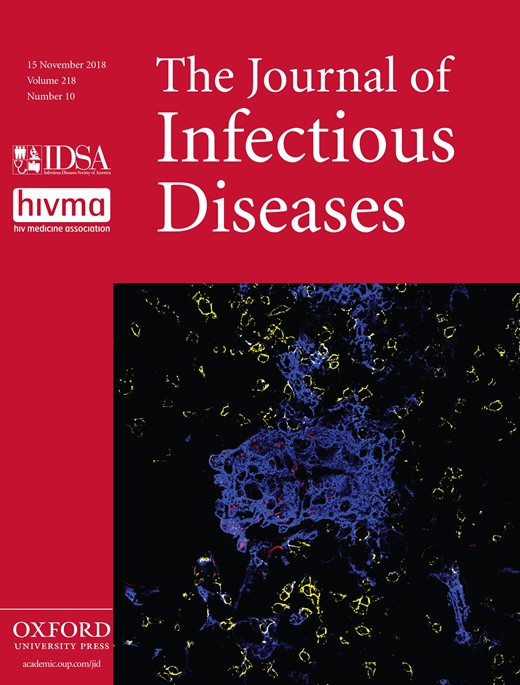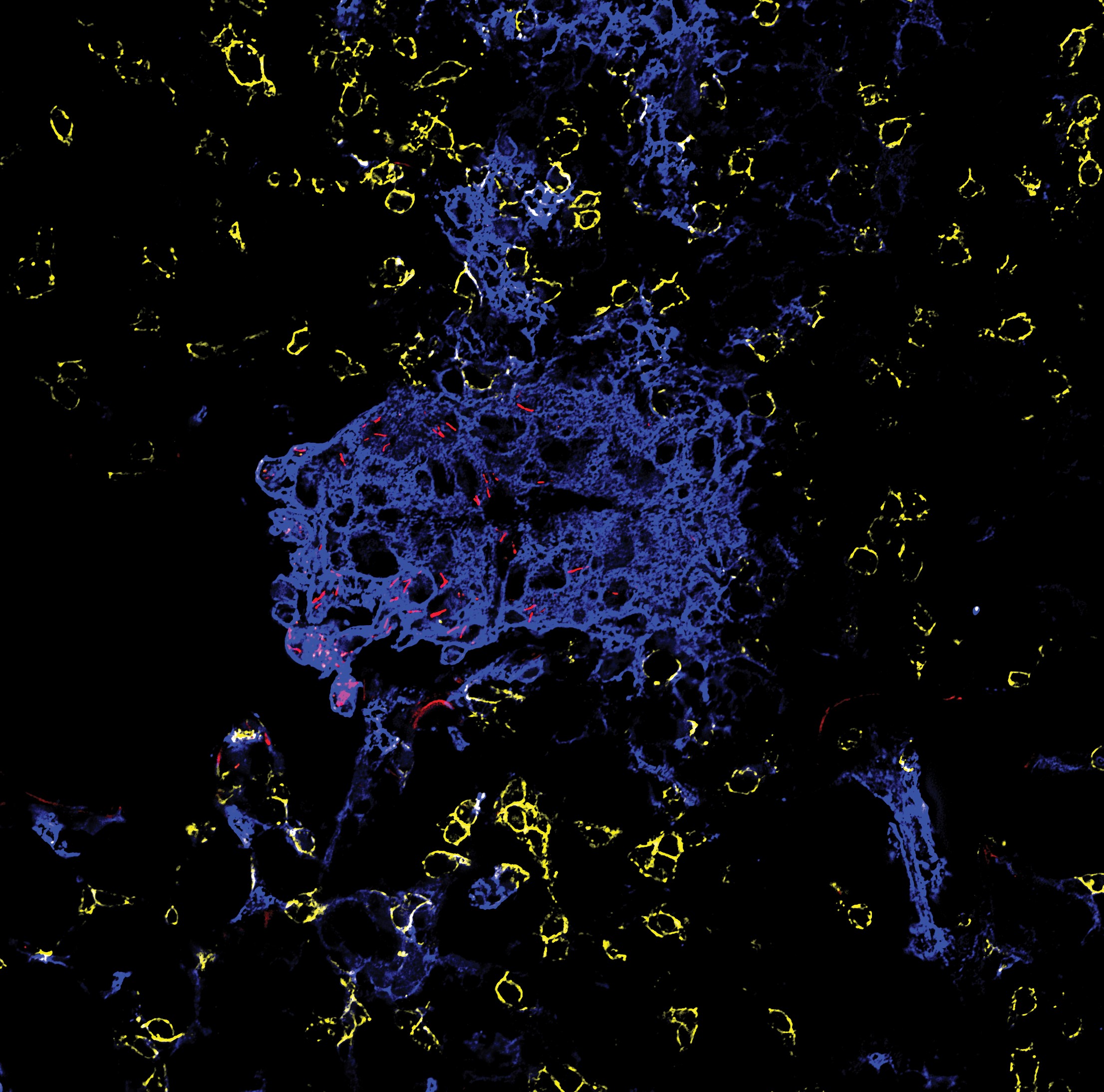
Cover image

Volume 218, Issue 10, 15 November 2018
EDITORIAL COMMENTARY
Leukocyte Telomere Length in HIV Infection: A Marker of Persistent Immune Aging or Transient Immune Reconstitution?
MAJOR ARTICLES AND BRIEF REPORTS
HIV/AIDS
Blood Telomere Length Changes After Ritonavir-Boosted Darunavir Combined With Raltegravir or Tenofovir-Emtricitabine in Antiretroviral-Naive Adults Infected With HIV-1
Antiretroviral-naive HIV-infected adults receiving ritonavir-boosted darunavir and tenofovir disoproxil fumarate/emtricitabine had a significant higher gain in blood telomere length than those receiving ritonavir-boosted darunavir and raltegravir, suggesting a better initial recovery from HIV-associated immunosenescence.
Impact of Nucleos(t)ide Reverse Transcriptase Inhibitors on Blood Telomere Length Changes in a Prospective Cohort of Aviremic HIV–Infected Adults
In human immunodeficiency virus–infected adults with prolonged virological suppression, treatment with tenofovir disoproxil fumarate or abacavir was associated with smaller gains in blood telomere length after 2 years of follow-up.
Liposome-Encapsulated Human Immunodeficiency Virus-1 gp120 Induces Potent V1V2-Specific Antibodies in Humans
The AVEG015 study highlights the importance of the inclusion of 2 adjuvants in the vaccine formulation. Incorporation of aluminum hydroxide and liposomal MPL induced robust and durable gp120 and gp70V1V2 IgG binding antibodies and ADCC and α4β7-integrin receptor-inhibiting functional antibodies.
Trajectories and Predictors of Longitudinal Preexposure Prophylaxis Adherence Among Men Who Have Sex With Men
Growth mixture modeling was used to identify trajectories of longitudinal self-reported (via text-messaging) preexposure prophylaxis adherence among men who have sex with men. Self-reported adherence was associated with pharmacologically assessed adherence. Baseline demographic and psychosocial factors predicted later adherence.
Effects of Substance Use and Sex Practices on the Intestinal Microbiome During HIV-1 Infection
Human immunodeficiency virus type 1 (HIV-1) infection alters the human intestinal microbiome; however, behavioral factors driving these changes remain poorly defined. We show that drug use and sex behavior are important factors associated with intestinal dysbiosis during chronic HIV-1 infection among young men who have sex with men.
VIRUSES
Influence of Immune Priming and Egg Adaptation in the Vaccine on Antibody Responses to Circulating A(H1N1)pdm09 Viruses After Influenza Vaccination in Adults
Analysis of antibody responses in adults from 6 influenza seasons after influenza vaccination suggest that both immune priming with seasonal H1N1 viruses earlier in life and egg adaptation in vaccines can affect antibody responses to circulating A(H1N1)pdm09 viruses after vaccination.
IFITM3 Restricts Human Metapneumovirus Infection
Human metapneumovirus (hMPV) is a respiratory pathogen for which there are currently no antivirals or vaccines. Here, we reveal that the endosomal innate immunity protein IFITM3 can restrict hMPV infection of cells through inhibition of hMPV membrane fusion.
High Viral Diversity and Mixed Infections in Cerebral Spinal Fluid From Cases of Varicella Zoster Virus Encephalitis
Cerebrospinal fluid varicella zoster virus (VZV) from encephalitis (8) was significantly more diverse than vesicular fluid (24) (P < .05) with mixed clade infection in 2. Nonvaricella-associated VZV encephalitides may be caused by simultaneous viral reactivation from multiple neurons.
Experimental Infection of Syrian Hamsters With Aerosolized Nipah Virus
Small-particle aerosolized Nipah virus Malaysia strain remains infectious and causes similar clinical manifestations of disease in the Syrian hamster model as using the corresponding liquid inoculum. Nipah droplets could therefore play a role in human-to-human transmission by close contact.
Impact of Naturally Occurring Variation in the Human Papillomavirus 58 Capsid Proteins on Recognition by Type-Specific Neutralizing Antibodies
We investigated the impact of lineage/sublineage variation within the capsid proteins of HPV58 and demonstrated differential sensitivity to antibodies derived from natural infection and immunization. These differences were likely due to subtle epitope sequence changes rather that major structural alterations.
Development of Mobile Laboratory for Viral Hemorrhagic Fever Detection in Africa
We developed a mobile laboratory for molecular detection of viral hemorrhagic fever viruses for an African team that tested its function during several outbreaks. This was the first team deployed onsite during the Ebola outbreak in West Africa 2014–2016.
FUNGI
The Major Surface Glycoprotein of Pneumocystis murina Does Not Activate Dendritic Cells
The major surface glycoprotein of Pneumocystis was unable to activate dendritic cells despite being able to bind to macrophage mannose receptor and DC-SIGN, which recognize mannoproteins, suggesting that the loss of genes in Pneumocystis for high mannosylation facilitates immune evasion.
BACTERIA
Group B Streptococcus Biofilm Regulatory Protein A Contributes to Bacterial Physiology and Innate Immune Resistance
This study investigates a group B Streptococcus LytR-CpsA-Psr enzyme which plays roles in multiple bacterial functions including biofilm formation, colonization, and innate immune resistance.
Limited Antimycobacterial Efficacy of Epitope Peptide Administration Despite Enhanced Antigen-Specific CD4 T-Cell Activation
Systemic administration of T cell epitope peptides increased activation of antigen-specific T cells in Mycobacterium tuberculosis-infected mice, but the antimycobacterial effect was modest. Additional work indicated that CD4 T cells are segregated from M. tuberculosis-infected cells in the lungs.
PATHOGENESIS AND HOST RESPONSE
Endocervical and Neutrophil Lipoxygenases Coordinate Neutrophil Transepithelial Migration to Neisseria gonorrhoeae
Apical infection of endocervical cells by Neisseria gonorrhoeae drives basolateral-to-apical neutrophil migration. Neutrophil transepithelial migration requires bacterial–endocervical cell contact. Two eicosanoid-producing pathways coordinate neutrophil migration: epithelial 12R-lipoxygenase (LOX) and eLOX3 hepoxilin synthase, and neutrophil 5-LOX–dependent production of leukotriene B4.
Activation of Peripheral T Follicular Helper Cells During Acute Dengue Virus Infection
We investigated the immune response of peripheral T follicular helper cells during acute dengue virus infection in Thai children. We report significant associations between peripheral T follicular helper cell activation and plasmablast activation, secondary infection, and disease.



